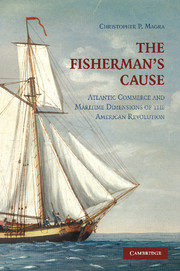Book contents
- Frontmatter
- Contents
- Acknowledgments
- Abbreviations
- Introduction
- Part One THE RISE OF THE COLONIAL COD FISHERIES
- Part Two ATLANTIC ORIGINS OF THE AMERICAN REVOLUTIONARY WAR
- Part Three THE MILITARY MOBILIZATION OF THE FISHING INDUSTRY
- 8 From Trade Routes to Supply Lines
- 9 The First American Navy
- 10 Starving the Enemy and Feeding the Troops
- 11 From Fishermen to Fighting Men
- Conclusion
- Index
- References
10 - Starving the Enemy and Feeding the Troops
Published online by Cambridge University Press: 03 July 2009
- Frontmatter
- Contents
- Acknowledgments
- Abbreviations
- Introduction
- Part One THE RISE OF THE COLONIAL COD FISHERIES
- Part Two ATLANTIC ORIGINS OF THE AMERICAN REVOLUTIONARY WAR
- Part Three THE MILITARY MOBILIZATION OF THE FISHING INDUSTRY
- 8 From Trade Routes to Supply Lines
- 9 The First American Navy
- 10 Starving the Enemy and Feeding the Troops
- 11 From Fishermen to Fighting Men
- Conclusion
- Index
- References
Summary
An army marches on its stomach.
Man does not live by bread alone.
While stationed at West Point on a sultry summer day in 1780, American Private Joseph Plumb Martin complained about his rations. Whether his grumblings stemmed from the sun's heat, the food's taste, or the constant complaint typical of soldiers cannot be determined with any precision. Whatever the cause, a disgusted Martin observed, “[O]ur rations, when we got any, consisted of bread and salt shad. This fish, as salt as fire, and dry as bread, without any kind of vegetables, was hard fare in such extreme hot weather as it was then. We were compelled to eat it as it was.”
The comments of one common foot soldier underscore a basic fact of war recognized by famous commanders such as Napoleon Bonaparte: troops require food to fight. Shad, a fish commonly found in North American rivers throughout the colonial period, offered sustenance to Martin and enabled him to perform his duties at West Point toward the end of the war, regardless of the fact that he found such food to be “hard fare.” Fish was also brought from the ocean to feed America's fighting men. Dried, salted cod played an important role in provisioning the troops during the Revolutionary War. Like shad, cod was cheaper than meat. The use of both types of fish as a military provision can therefore be seen as a cost-saving measure. There, however, the comparisons end.
- Type
- Chapter
- Information
- The Fisherman's CauseAtlantic Commerce and Maritime Dimensions of the American Revolution, pp. 199 - 214Publisher: Cambridge University PressPrint publication year: 2009



